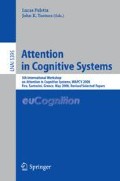Abstract
Attention and memory are very closely related and their aim is to simplify the acquired data into an intelligent structured data set. Two main points are discussed in this paper. The first one is the presentation of a novel visual attention model for still images which includes both a bottom-up and a top-down approach. The bottom-up model is based on structures rarity within the image during the forgetting process. The top-down information uses mouse-tracking experiments to build models of a global behavior for a given kind of image. The proposed models assessment is achieved on a 91-image database. The second interesting point is that the relative importance of bottom-up and top-down attention depends on the specificity of each image. In unknown images the bottom-up influence remains very important while in specific kinds of images (like web sites) top-down attention brings the major information.
Access this chapter
Tax calculation will be finalised at checkout
Purchases are for personal use only
Preview
Unable to display preview. Download preview PDF.
References
Hollingworth, A.: Constructing visual representations from natural scenes: The roles of short- and long-term visual memory. Journal of Experimental Psychology: Human Perception and Performance 30, 519–537 (2004)
Chun, M.M., Jiang, Y.: Implicit, long-term spatial context memory. Journal of Experimental Psychology: Learning, Memory, & Cognition 29, 224–234 (2003)
Desimone, R.: Visual attention mediated by biased competition in extrastriate visual cortex. Phil. Trans. R. Soc. Lond. B 353, 1245–1255 (1998)
Boynton, G.M.: Attention and visual perception. Current Opinion in Neurobiology 15, 465–469 (2005)
Itti, L., Koch, C., Niebur, E.: Model of saliency-based visual attention for rapid scene analysis. IEEE Trans. on Pattern Analysis and Machine Intelligence 20(11), 1254–1259 (1998)
Itti, L., Koch, C.: A saliency-based search mechanism for overt and covert shifts of visual attention. Vision Research 40, 1489–1506 (2000)
Itti, L., Koch, C.: Computational modeling of visual attention. Nature RevNeuroscience 2(3), 194–203 (2001)
Koch, C., Ullman, S.: Shifts in selective visual attention: towards the underlying neural circuitry. Human Neurobiology 4(4), 219–270 (1985)
Milanese, R., Bost, J.M., Pun, T.: A bottom-up attention system for active vision. In: ECAI 1992, 10th European Conference on Artificial Intelligence, pp. 808–810 (1992)
Milanese, R.: Detecting salient regions in an image: from biological evidence to computer implementation. PhD Thesis, University of Geneva (1993)
Chauvin, A., Herault, J., Marendaz, C., Peyrin, C.: Natural scene perception: visual attractors and image processing. In: 7th Neural Computation and Psychology Workshop (2000)
Petkov, N., Westenberg, M.A.: Suppression of contour perception by band-limited noise and its relation to non-classical receptive field inhibition. Biological Cybernetics 88, 236–246 (2003)
Le Meur, O.: Attention sélective en visualisation d’images fixes et animées affichées sur écran: Modèles et évaluation des performances – Applications. PhD Thesis, University of Nantes (2005)
Le Meur, O., Le Callet, P., Barba, D.: A spatio-temporal model of bottom-up visual selective attention: description and assessment. Vision Research (2007)
Mudge, T.N., Turney, J.L., Volz, R.A.: Automatic generation of salient features for the recognition of partially occluded parts. Robotica 5, 117–127 (1987)
Osberger, W., Maeder, A.J.: Automatic identification of perceptually important regions in an image. In: 14th IEEE Int. Conference on Pattern Recognition (1998)
Walker, K.N., Cootes, T.F., Taylor, C.J.: Locating Salient Object Features. In: British Machine Vision Conference (1998)
Oliva, A., Torralba, A.: Modeling the shape of the scene: a holistic representation of the spatial envelope. International Journal of Computer Vision 43(3), 145–175 (2001)
Oliva, A., Torralba, A., Castelhano, M.S., Henderson, J.M.: Top-down control of visual attention in object detection. In: IEEE International Conference on Image Processing (2003)
Bruce, N., Jernigan, E.: Evolutionary design of context-free attentional operators. In: Proc. of the IEEE International Conference on Image Processing (2003)
Bruce, N., Tsotsos, J.K.: Saliency Based on Information Maximization. In: Proc. of the Neural Information Processing Systems (2005)
Liu, F., Gleicher, M.: Video Retargeting: Automating Pan-and-Scan. ACM Multimedia (2006)
Comaniciu, D., Meer, P.: Mean Shift: A Robust Approach toward Feature Space Analysis. IEEE Trans. Pattern Analysis Machine Intell. 24(5), 603–619 (2002)
Itti, L., Baldi, P.: Bayesian Surprise Attracts Human Attention. In: Advances in Neural Information Processing Systems (NIPS 2005), vol. 19, pp. 1–8. MIT Press, Cambridge (2006)
Stentiford, F.W.M.: An estimator for visual attention through competitive novelty with application to image compression. In: Picture Coding Symposium, pp. 25–27 (2001)
Boiman, O., Irani, M.: Detecting Irregularities in Images and in Video. In: International Conference on Computer Vision (ICCV) (2005)
Boiman, O., Irani, M.: Similarity by Composition. In: Neural Information Processing Systems (NIPS) (2006)
Mancas, M., Mancas-Thillou, C., Gosselin, B., Macq, B.: A rarity-based visual attention map - application to texture description. In: Proc. of IEEE International conference on Image Processing (ICIP) (2006)
Mancas, M., Gosselin, B., Macq, B.: A Three-Level Computational Attention Model. In: Proceedings of ICVS Workshop on Computational Attention & Applications (WCAA) (2007)
Mancas, M., Gosselin, B., Macq, B.: Perceptual Image Representation, EURASIP Journal of Image and Video Processing, Article ID 98181, doi:10.1155/2007/98181 (2007)
Validattention website, http://tcts.fpms.ac.be/~mousetrack/pageAccueil.php?langue=en
Author information
Authors and Affiliations
Editor information
Editors and Affiliations
Rights and permissions
Copyright information
© 2009 Springer-Verlag Berlin Heidelberg
About this paper
Cite this paper
Mancas, M. (2009). Relative Influence of Bottom-Up and Top-Down Attention. In: Paletta, L., Tsotsos, J.K. (eds) Attention in Cognitive Systems. WAPCV 2008. Lecture Notes in Computer Science(), vol 5395. Springer, Berlin, Heidelberg. https://doi.org/10.1007/978-3-642-00582-4_16
Download citation
DOI: https://doi.org/10.1007/978-3-642-00582-4_16
Publisher Name: Springer, Berlin, Heidelberg
Print ISBN: 978-3-642-00581-7
Online ISBN: 978-3-642-00582-4
eBook Packages: Computer ScienceComputer Science (R0)

